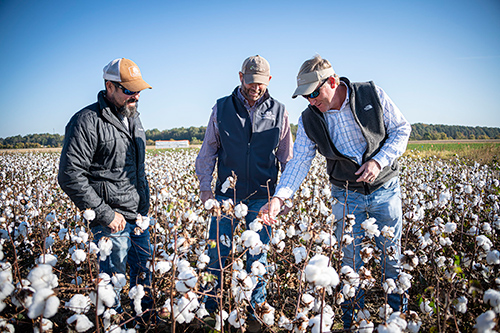MSU scientists tackle herbicide-resistant weeds with high-tech innovation
Contact: Trey Barrett

STARKVILLE, Miss.—A Mississippi State research team in the university’s Department of Plant and Soil Sciences is using artificial intelligence and automated mechanical technology capabilities to find and control weeds.
Cotton Inc. recently funded a study, asking scientists in MSU’s Mississippi Agricultural and Forestry Experiment Station to design a tool to automate controlling herbicide-resistant weeds in cotton.
Brian Pieralisi, an assistant professor of plant and soil sciences, said years of repeatedly applying the same herbicides have led to this need.
“While chemical solutions are available, plants build herbicide resistance after years of exposure,” Pieralisi said.
Today, farmers have access to technology-driven weed control systems that eliminate the need for traditional broadcast spraying methods. While AI technology built into commercial machinery has improved weed control methods, it doesn’t address herbicide-resistant weeds.
“Our goal is to control weeds while minimizing the impacts on the field. We want a machine to know when to till herbicide-resistant weeds and large weeds, which are hard to control with herbicides, and when to spot spray weeds that have not shown resistance,” Pieralisi said.
The team outfitted a common row crop cultivator with intelligent cameras made by German technology company IDS to site-specifically remove weeds with hydraulically actuated tillage and/or selectively applying herbicides to susceptible weeds only. This method reduced potential herbicide resistance and focused soil disruptions to areas around weeds only. These targeted treatments minimize soil moisture losses and prevent disruption to residual herbicide weed control in place, said Wes Lowe, assistant professor in the Department of Agricultural and Biological Engineering.
“We’re currently compiling a robust collection of weed images and creating models, so the cameras’ AI selects the appropriate action to take to best control the weed relative to species and physiological maturity,” Lowe said. “If we could build out the database and log species we see in the field each year, we might answer some questions about the effectiveness of—or resistance to—herbicides.”
Daniel Chesser, also an assistant professor of agricultural and biological engineering, said the concept of integrating new technology with existing equipment allows farmers to benefit from the latest technology with less financial risk.
“Adapting existing equipment with new technology is a trend we’re seeing in the AI and machine learning fields,” said Chesser. “Farmers look to this technology to alleviate labor costs and optimize their production systems. In the future, our tool could potentially be integrated into an autonomous system that would traverse a field by itself, further reducing labor costs.”
For more information on MSU’s Department of Agricultural and Biological Engineering, visit www.abe.msstate.edu. For more information on the Department of Plant and Soil Sciences, visit www.pss.msstate.edu. For more about MAFES, visit www.mafes.msstate.edu.
MSU is Mississippi’s leading university, available online at www.msstate.edu.